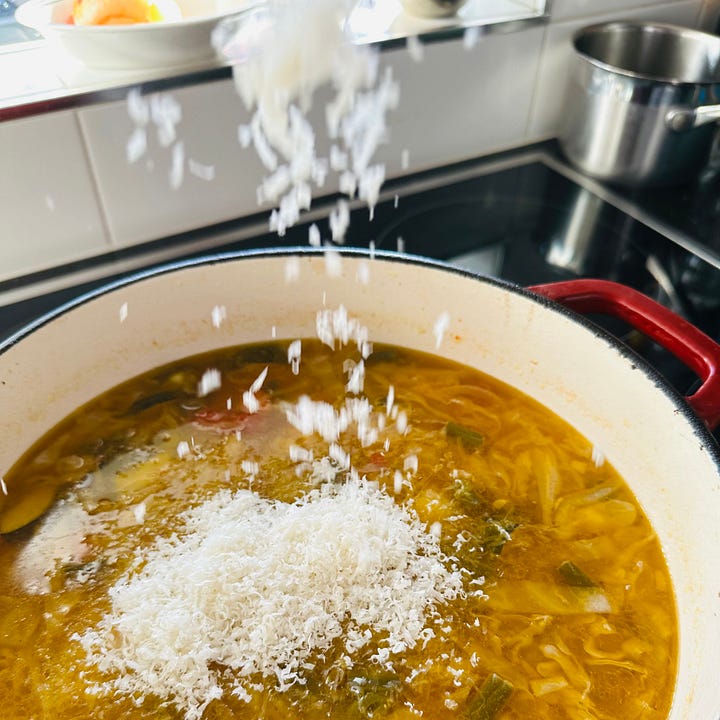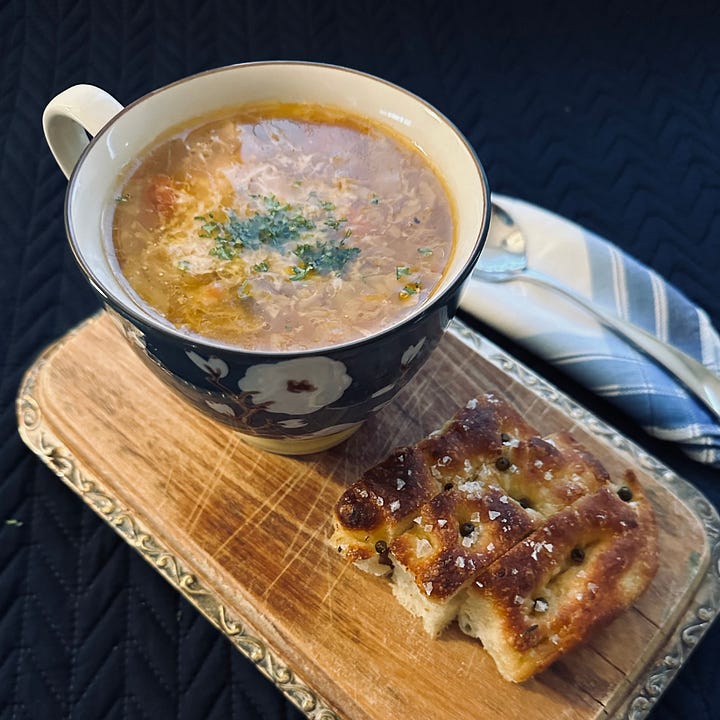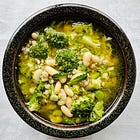Minestrone di Romagna: Cooking Marcella’s Vegetable Soup
A timeless Italian soup, cooked the Marcella way
During the pandemic, I returned to nursing. I was back in the community as an RN, visiting people who were sick, wounded, dying, or simply needing support to remain independent. It was varied, meaningful work, often exhausting, especially in peak summer, encased in full PPE—but always fulfilling. Every day, in some small way, I was making a difference.
There are so many stories I could share from that time, but today I want to talk about Marcella’s minestrone, so I must narrow my focus to Silvio. I suppose he was my favourite.
Silvio was a relatively new widower, and from the moment I met him, it was clear that food had been at the heart of his life with his late wife, Anna. She had been an exceptional cook, and though grief weighed heavy on him, he found solace in the kitchen. My visits were brief, just a medication prompt, observations, a chat, but they always revolved around food. More than once, I checked his stove under the guise of assessing fire risk, only to realise he didn’t need my interference. He had everything under control.
We talked about whatever was simmering that day, the butcher he’d visited for his meat, the exact process behind the dish, how he’d be serving it. Even now, I can recall a handful of the recipes he shared. He was a marvel.
One evening, I mentioned I’d made Marcella’s minestrone that weekend and offered to bring him some. He accepted, and the next day, I handed over a container of soup, eager to hear his feedback. He did not disappoint. Silvio, like many of his generation, had no hesitation in delivering the whole truth.
He had notes. Written in his tremulous hand, they were full of very clear instructions on how to make minestrone properly. I had made a series of errors, it seemed. The sweet potato? That was a mistake. But my greatest offence? The cabbage.
According to Silvio, cabbage must be cut into large chunks and simmered gently in the broth until tender. Then, it is lifted out, squeezed thoroughly to extract its stock, then rolled into a tight ball before slicing into delicate shreds. Only then may it return to the pot.
I slipped his notes into my copy of “The Classic Italian Cookbook”, tucking them into the pages of Minestrone di Romagna, where I rediscovered them this past weekend as I revisited this recipe. Today, I’m giving you Marcella’s minestrone exactly as she instructs, as that is the commitment of this Substack. But in truth? I always make it Silvio’s way now. I would never again be so bold as to throw in some errant vegetable or take liberties with the cabbage.
Minestrone di Romagna: A Soup for All Seasons
In Italy, soups are deeply tied to both the time of year and their region of origin. The ingredients shift with the seasons, winter’s root vegetables and sturdy greens give way to summer’s tender courgettes and fresh basil. Where you are in Italy shapes not just the ingredients but the very nature of the dish itself. A minestrone from the north, for example, will often include rice, while those from central regions are likely to be thickened with beans and served with rustic bread. In the south, a more tomato-forward version might be enriched with olive oil and garlic.
Despite these variations, one thing unites Italian soups: they are never insubstantial. Whether thick or brothy, vegetable-based or legume-heavy, their ingredients remain distinct, never blended into anonymity. There are no puréed or cream-laden soups in Italy’s traditional repertoire. A proper minestrone preserves the integrity of its ingredients while allowing them to meld into something greater than the sum of their parts.


Minestrone alla Romagnola - Vegetable Soup, Romagna Style
In Romagna, this is how minestrone is made. A mix of seasonal vegetables is gently built upon a base of onions, carrots, celery, and potatoes, ingredients that are always available. Everything is added in careful succession, allowing each element to develop its flavour before the next is introduced. The slow cooking process allows the vegetables to merge into a mellow, deeply layered soup where no single ingredient dominates, yet each contributes to the whole.
A crucial detail: the order of cooking matters. The onion must be sautéed first, forming the foundation upon which everything else rests. While one vegetable is simmering, another can be chopped, making the process more efficient. However, if it’s more convenient to prep everything in advance, the key is to follow the sequence of additions precisely.


Minestrone alla Romagnola
Serves 6 to 8
Ingredients:
450g fresh courgettes-Zucchini
8 tbsp extra-virgin olive oil
45g butter
3 onions, very thinly sliced
4 carrots, diced
2 celery stalks, diced
225g potatoes, peeled and diced
115g fresh French beans, trimmed and diced
170g shredded Savoy cabbage (or other cabbage variety)
400g tinned cannellini beans, drained
1.5 litres homemade meat broth (or 500ml tinned beef consommé plus 1 litre water)
Parmesan rind, cleaned (optional)
170g tinned Italian plum tomatoes, with their juice
Salt to taste
6 tbsp freshly grated Parmigiano-Reggiano
Method:
Soak the courgettes-zucchini in cold water for about 20 minutes, then trim and finely dice them.
In a large saucepan, warm the olive oil and butter over medium-low heat. Add the onions and cook until soft and golden.
Stir in the diced carrots and cook for a few minutes, then add the celery, followed by the potatoes, allowing each to cook briefly before adding the next.
While the earlier vegetables are cooking, rinse and dice the French beans. Add them to the pot, followed by the courgettes. After another few minutes, stir in the cabbage.
Pour in the broth, along with the tomatoes and their juices. If using, add the Parmesan rind for added depth. Season lightly with salt. Stir well, cover, and let the soup simmer gently for at least 3 hours.
Stir in the drained cannellini beans in the last 15 mins of cooking time and adjust with additional broth or water if needed. The final consistency should be thick and hearty, never watery.
Just before serving, remove the Parmesan rind, stir in the grated cheese, taste, and adjust the seasoning if necessary.
Make-Ahead Tip
Minestrone improves with time. It’s even better the next day and will keep in a sealed container in the fridge for up to a week.
Menu Suggestions
Pairs beautifully with roasts, particularly lamb. Serve it before any meat dish that doesn’t already feature vegetables.


Minestrone Freddo alla Milanese
Summer Vegetable Soup with Rice and Basil, Milan Style
This lighter, Milanese variation is a warm-weather favourite. Traditionally, trattorie prepare it in the early morning, setting bowls out to cool in time for lunch. A bowl of this delicate, herb-laced soup might be accompanied by crisp raw vegetables for pinzimonio, poached fish, or Parma ham with ripe summer fruit.
One of its great advantages is that it can be made in stages. The base soup can be prepared a day or two ahead, making the final preparation effortless. The soup needs at least an hour to settle before serving, allowing the flavours to meld beautifully.
Serves 4
Ingredients:
500ml Minestrone alla Romagnola
500ml water
115g Arborio rice
Salt and freshly ground black pepper
4 tbsp grated Parmigiano-Reggiano
8–10 fresh basil leaves, torn
2 tbsp extra-virgin olive oil
Method:
In a saucepan, bring the minestrone and water to a boil. Stir in the rice.
Once the soup returns to a boil, season with salt and pepper, cover, and lower the heat to medium-low. Stir occasionally and begin testing the rice after 12 minutes.
Just before turning off the heat, swirl in the grated Parmesan. Taste and adjust seasoning.
Ladle into bowls and scatter with fresh basil. Let rest until the soup has cooled to room temperature before serving. Drizzle each bowl with olive oil


Minestrone with Pesto (Hot or Cold)
Adding pesto transforms minestrone into something deeply aromatic.
Cold Version: Stir 1 tbsp pesto into the finished Minestrone Freddo before serving.
Hot Version: Stir 1½ to 2 tbsp of pesto into the Minestrone alla Romagnola just before serving.


Marcella’s minestrone is a lesson in patience, simplicity, and respect for ingredients. But if I’m honest, I’ll always carry a little of Silvio’s minestrone with me too.
Marcella Soup Series
Do press the little heart and share this post if you’ve enjoyed it. I’d love to know how you make spinach soup, is it as easy as Marcella’s recipe?
I’d love you to subscribe to Cooking with Marcella if you haven’t already, it would be just lovely to have your company.
©Lisa McLean 2025
All photography by ©Lisa McLean 2025
Recipe attribution of all recipes on this project unless otherwise stated are from Marcella Hazan
References
Hazan, Marcella. Koizumi, George. "The classic Italian cook book: the art of Italian cooking and the Italian art of eating." Macmillan London. 1973
Hazan, Marcella. Koizumi, George. "The classic Italian cook book: the art of Italian cooking and the Italian art of eating." Boxtree Publisher, Sept 2022.













I really enjoyed this post Lisa. I loved your story of Silvio and his notes. I think I will cook my cabbage this way now too
What a beautiful post, Thank you- Lisa! And also thank you for showing up and taking care of Silvio, and countless others during uncertain times. We need more angels like you in this world